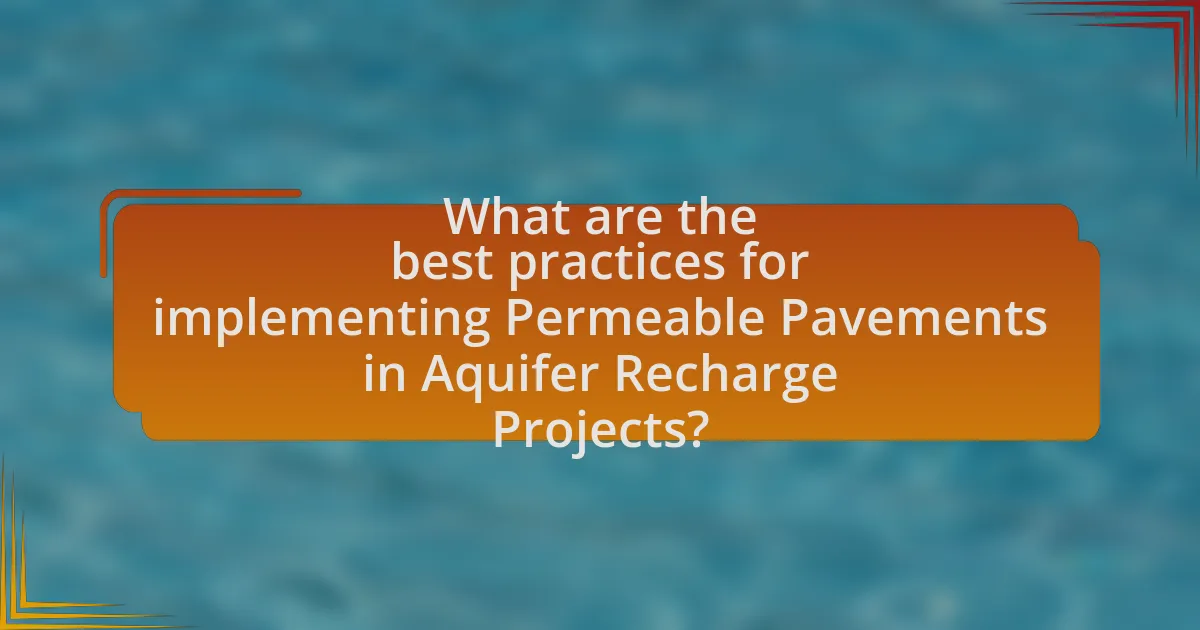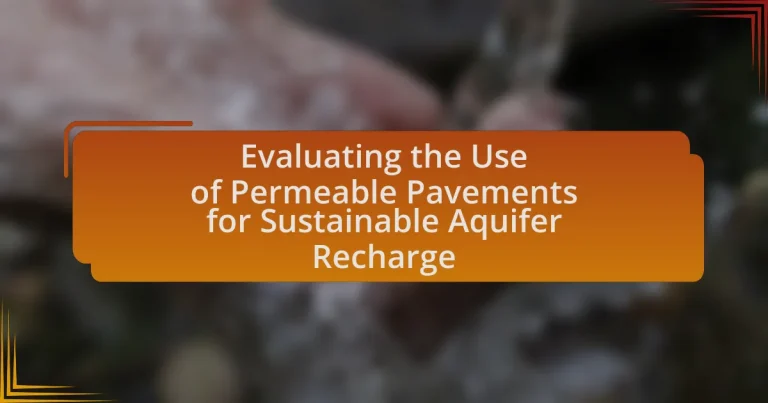Permeable pavements are innovative surfaces designed to facilitate groundwater recharge by allowing water to infiltrate through them, thereby reducing surface runoff. This article evaluates the role of permeable pavements in sustainable aquifer recharge, discussing their construction materials, functionality in water management, and environmental benefits. It highlights the importance of proper design, maintenance practices, and site selection for maximizing their effectiveness, as well as the economic implications and challenges associated with their implementation. Additionally, the article explores how permeable pavements can be integrated into urban planning to enhance stormwater management and support local ecosystems.
What are Permeable Pavements and Their Role in Aquifer Recharge?

Permeable pavements are surfaces designed to allow water to infiltrate through them, facilitating groundwater recharge. These pavements, which include materials like porous asphalt, permeable concrete, and interlocking pavers, enable rainwater and runoff to pass through, reducing surface water runoff and promoting aquifer replenishment. Studies indicate that permeable pavements can significantly enhance aquifer recharge rates by allowing precipitation to directly infiltrate into the soil, where it can percolate down to the groundwater table. For instance, research published in the journal “Water” demonstrates that permeable pavements can increase groundwater recharge by up to 50% compared to traditional impervious surfaces.
How do permeable pavements function in water management?
Permeable pavements function in water management by allowing rainwater to infiltrate through their surface, reducing surface runoff and promoting groundwater recharge. This infiltration process helps to manage stormwater effectively, mitigating flooding and erosion while filtering pollutants from the water before it reaches the aquifer. Studies have shown that permeable pavements can significantly decrease the volume of runoff; for instance, research indicates that they can reduce runoff by up to 80% compared to traditional impervious surfaces. This capability supports sustainable aquifer recharge by facilitating the natural filtration and replenishment of groundwater resources.
What materials are used in the construction of permeable pavements?
Permeable pavements are constructed using materials such as porous asphalt, permeable concrete, and interlocking concrete pavers. These materials are designed to allow water to infiltrate through the surface, reducing runoff and promoting groundwater recharge. Porous asphalt consists of a mixture of asphalt and aggregate that creates voids for water passage. Permeable concrete is a specially formulated concrete with larger aggregates and fewer fine materials, enhancing its permeability. Interlocking concrete pavers feature gaps between the units filled with gravel or sand, facilitating water infiltration. These materials collectively support sustainable aquifer recharge by managing stormwater effectively.
How does the design of permeable pavements influence water infiltration?
The design of permeable pavements significantly enhances water infiltration by allowing water to pass through the surface and into the underlying soil layers. This is achieved through the use of materials with high porosity and a structured layout that includes void spaces, which facilitate the movement of water. Studies have shown that permeable pavements can reduce surface runoff by up to 80%, promoting groundwater recharge and mitigating flooding. The incorporation of aggregate materials and specific drainage systems in the design further optimizes the infiltration process, ensuring that rainwater is effectively absorbed rather than contributing to surface water accumulation.
Why is sustainable aquifer recharge important?
Sustainable aquifer recharge is important because it enhances groundwater levels, ensuring a reliable water supply for various uses. This process mitigates the impacts of drought and climate change by replenishing aquifers, which are critical for drinking water, agriculture, and ecosystem health. Studies indicate that sustainable practices, such as using permeable pavements, can significantly increase the amount of water that infiltrates into the ground, thereby improving aquifer sustainability and reducing surface runoff.
What are the environmental benefits of aquifer recharge?
Aquifer recharge provides significant environmental benefits, including improved water quality, enhanced biodiversity, and increased groundwater availability. By allowing water to percolate through the soil, aquifer recharge helps filter pollutants, thus improving the quality of water that enters the aquifer. Additionally, it supports ecosystems by maintaining wetland habitats and promoting biodiversity, as many species rely on groundwater for survival. Furthermore, replenishing aquifers increases the availability of groundwater, which is crucial for agricultural irrigation and drinking water supplies, especially in arid regions. These benefits collectively contribute to sustainable water management and environmental health.
How does aquifer recharge contribute to water sustainability?
Aquifer recharge significantly contributes to water sustainability by replenishing groundwater supplies, which are essential for maintaining water availability during dry periods. This process helps to balance the hydrological cycle, ensuring that water resources are preserved for agricultural, industrial, and domestic use. Studies indicate that effective aquifer recharge can enhance groundwater levels, reduce surface runoff, and improve water quality by filtering pollutants through soil layers. For instance, a report by the United Nations highlights that sustainable groundwater management, including aquifer recharge, is crucial for achieving water security and supporting ecosystems.
What challenges are associated with using permeable pavements for aquifer recharge?
The challenges associated with using permeable pavements for aquifer recharge include potential clogging, maintenance requirements, and the need for proper site selection. Clogging can occur due to sediment accumulation, which reduces permeability and impedes water infiltration. Regular maintenance is necessary to ensure the effectiveness of the pavement, as neglect can lead to decreased performance over time. Additionally, the effectiveness of permeable pavements is highly dependent on site conditions, such as soil type and hydrology, which must be carefully evaluated to ensure successful aquifer recharge.
What maintenance practices are necessary for permeable pavements?
Regular maintenance practices for permeable pavements include vacuum sweeping, periodic inspection, and replenishing the aggregate layer. Vacuum sweeping removes debris and sediment that can clog the surface, ensuring optimal water infiltration. Periodic inspections help identify any structural issues or blockages, allowing for timely repairs. Replenishing the aggregate layer maintains the permeability and structural integrity of the pavement. These practices are essential for sustaining the functionality of permeable pavements, which are designed to enhance aquifer recharge by allowing water to pass through and reduce surface runoff.
How do climate and soil conditions affect the effectiveness of permeable pavements?
Climate and soil conditions significantly influence the effectiveness of permeable pavements by affecting water infiltration rates and pollutant removal. In regions with high rainfall, permeable pavements can effectively manage stormwater, reducing surface runoff and promoting groundwater recharge. Conversely, in arid climates, the limited precipitation may lead to reduced functionality, as the pavements may not receive enough water to maintain their permeability.
Soil type also plays a crucial role; sandy soils facilitate faster drainage and enhance the performance of permeable pavements, while clayey soils can impede water movement, leading to potential clogging and reduced effectiveness. Studies have shown that permeable pavements in areas with well-drained soils can achieve infiltration rates exceeding 90%, while those in poorly drained soils may experience significant reductions in performance.
How can permeable pavements be integrated into urban planning?
Permeable pavements can be integrated into urban planning by incorporating them into the design of streets, parking lots, and public spaces to enhance stormwater management and promote groundwater recharge. This integration allows for the reduction of surface runoff, which can lead to flooding and water quality issues. Studies have shown that permeable pavements can reduce runoff by 50-100%, depending on the design and local conditions, thereby improving the sustainability of urban environments. Additionally, urban planners can implement policies and incentives that encourage the use of permeable materials in new developments and retrofitting existing surfaces, aligning with sustainable development goals and enhancing urban resilience.
What are the economic implications of implementing permeable pavements?
Implementing permeable pavements has significant economic implications, primarily through cost savings in stormwater management and infrastructure maintenance. By allowing water to infiltrate through the pavement, municipalities can reduce the need for expensive drainage systems and mitigate flooding, which can lead to lower maintenance costs over time. A study by the U.S. Environmental Protection Agency indicates that permeable pavements can reduce stormwater runoff by up to 80%, leading to decreased expenditures on water treatment and flood control infrastructure. Additionally, permeable pavements can enhance property values by improving aesthetics and reducing localized flooding, which can further stimulate economic growth in urban areas.
What are the specific benefits of using Permeable Pavements for Aquifer Recharge?

Permeable pavements significantly enhance aquifer recharge by allowing water to infiltrate through the surface, reducing runoff and promoting groundwater replenishment. This infiltration process helps to filter pollutants, improving water quality as it percolates through the pavement and underlying soil layers. Studies indicate that permeable pavements can increase the volume of water that reaches aquifers, with some research showing infiltration rates of up to 90% compared to traditional impervious surfaces. Additionally, they mitigate urban flooding by managing stormwater effectively, which further supports aquifer recharge by maintaining a balanced hydrological cycle.
How do permeable pavements improve stormwater management?
Permeable pavements improve stormwater management by allowing water to infiltrate through the surface, reducing runoff and promoting groundwater recharge. This infiltration process helps to mitigate flooding and erosion by decreasing the volume and speed of stormwater flow. Studies indicate that permeable pavements can reduce surface runoff by up to 80%, effectively managing stormwater and enhancing aquifer recharge.
What role do permeable pavements play in reducing urban flooding?
Permeable pavements play a crucial role in reducing urban flooding by allowing rainwater to infiltrate through the surface and into the underlying soil, thereby decreasing surface runoff. This infiltration process helps to manage stormwater more effectively, reducing the volume of water that can overwhelm drainage systems during heavy rainfall. Studies have shown that permeable pavements can reduce runoff by up to 50% compared to traditional impervious surfaces, significantly mitigating the risk of urban flooding.
How do they enhance water quality in urban areas?
Permeable pavements enhance water quality in urban areas by allowing rainwater to infiltrate through the surface, reducing runoff and filtering pollutants. This infiltration process helps to recharge groundwater aquifers while simultaneously decreasing the volume of stormwater that can carry contaminants into local water bodies. Studies have shown that permeable pavements can significantly lower levels of heavy metals and other pollutants in urban runoff, thereby improving the overall quality of water entering the drainage systems.
What are the long-term benefits of permeable pavements for local ecosystems?
Permeable pavements provide significant long-term benefits for local ecosystems by enhancing water infiltration and reducing surface runoff. This increased infiltration allows for groundwater recharge, which is crucial for maintaining aquifer levels and supporting local water supplies. Additionally, permeable pavements help filter pollutants from stormwater, improving water quality in nearby streams and rivers. Studies have shown that areas with permeable pavements can experience a reduction in urban heat island effects, promoting a more stable microclimate that supports diverse plant and animal life. Furthermore, these pavements can contribute to habitat creation by allowing vegetation to grow in and around the permeable surfaces, fostering biodiversity.
How do permeable pavements support biodiversity?
Permeable pavements support biodiversity by allowing water to infiltrate the ground, which enhances soil moisture and promotes plant growth. This increased vegetation provides habitat and food sources for various species, including insects, birds, and small mammals. Studies have shown that areas with permeable pavements can sustain a greater diversity of plant species compared to traditional impervious surfaces, as they facilitate the natural hydrological cycle and reduce urban heat effects. For instance, research published in the journal “Ecological Engineering” indicates that permeable pavements can improve local biodiversity by creating microhabitats that support different ecological niches.
What impact do they have on local wildlife habitats?
Permeable pavements have a positive impact on local wildlife habitats by enhancing water infiltration and reducing surface runoff. This improved water management supports the growth of vegetation, which in turn provides food and shelter for various species. Studies indicate that permeable pavements can help maintain the hydrological cycle, thereby promoting biodiversity in urban areas. For instance, research published in the journal “Ecological Engineering” demonstrates that permeable surfaces can increase the abundance of plant species, which are crucial for sustaining local fauna.
What are the best practices for implementing Permeable Pavements in Aquifer Recharge Projects?

The best practices for implementing permeable pavements in aquifer recharge projects include proper site assessment, selecting appropriate materials, ensuring adequate maintenance, and integrating with existing drainage systems. Conducting a thorough site assessment helps identify soil types, groundwater levels, and potential contaminants, which are crucial for effective design. Choosing materials that facilitate water infiltration while providing structural integrity is essential; for instance, using porous asphalt or permeable concrete can enhance permeability. Regular maintenance, such as cleaning and repairing surface damage, ensures long-term functionality and prevents clogging. Additionally, integrating permeable pavements with existing drainage systems optimizes water flow and enhances recharge efficiency. These practices are supported by studies indicating that well-designed permeable pavements can significantly improve groundwater recharge rates and reduce surface runoff.
How can stakeholders effectively collaborate on permeable pavement projects?
Stakeholders can effectively collaborate on permeable pavement projects by establishing clear communication channels, defining roles and responsibilities, and engaging in joint decision-making processes. Effective collaboration requires stakeholders, including local governments, engineers, environmental groups, and community members, to share their expertise and perspectives from the project’s inception. Research indicates that projects with stakeholder involvement from the planning phase experience higher success rates, as seen in the case of the City of Portland’s Green Streets program, which integrated community feedback and technical input to enhance project outcomes. This collaborative approach not only fosters trust but also leads to innovative solutions that address both environmental and community needs.
What roles do local governments and communities play in these projects?
Local governments and communities play crucial roles in the implementation and success of permeable pavement projects for sustainable aquifer recharge. Local governments are responsible for establishing regulations, providing funding, and facilitating planning processes that support the installation of permeable pavements. They often collaborate with community stakeholders to ensure that projects meet local needs and environmental standards. Communities contribute by participating in decision-making, advocating for sustainable practices, and maintaining the infrastructure once installed. For instance, studies have shown that community engagement in environmental projects leads to higher success rates and better maintenance outcomes, as seen in various urban areas that have adopted permeable pavement systems.
How can public awareness be raised about the benefits of permeable pavements?
Public awareness about the benefits of permeable pavements can be raised through targeted educational campaigns that highlight their environmental advantages, such as reducing stormwater runoff and improving groundwater recharge. These campaigns can utilize workshops, community events, and social media platforms to disseminate information, showcasing case studies where permeable pavements have successfully mitigated flooding and enhanced local ecosystems. Research indicates that communities with increased awareness of sustainable practices, including permeable pavements, are more likely to adopt such technologies, as evidenced by a study published in the Journal of Environmental Management, which found that public education significantly influences community acceptance of green infrastructure solutions.
What are the key considerations for selecting sites for permeable pavements?
Key considerations for selecting sites for permeable pavements include soil permeability, drainage capacity, existing land use, and environmental impact. Soil permeability is crucial as it determines how well water can infiltrate through the pavement; ideally, the underlying soil should have high infiltration rates. The drainage capacity of the site must be assessed to ensure that it can handle stormwater runoff effectively without causing flooding. Existing land use is important to evaluate compatibility with permeable pavements, as areas with heavy traffic or industrial activities may require more durable solutions. Lastly, the environmental impact should be considered, including effects on local ecosystems and groundwater recharge, as permeable pavements are intended to enhance aquifer recharge by allowing water to infiltrate and replenish groundwater supplies.
How do hydrological assessments inform site selection?
Hydrological assessments inform site selection by evaluating water flow, drainage patterns, and groundwater levels, which are critical for determining the suitability of a location for permeable pavements. These assessments provide data on soil permeability, surface runoff, and potential flooding risks, enabling planners to identify areas where permeable pavements can effectively enhance aquifer recharge. For instance, studies have shown that sites with high infiltration rates and low runoff potential are ideal for implementing permeable pavement systems, as they facilitate water absorption and reduce surface water accumulation.
What factors should be considered regarding existing infrastructure?
Factors to consider regarding existing infrastructure include the condition and capacity of current drainage systems, the compatibility of permeable pavements with existing materials, and the potential impact on local hydrology. Assessing the condition of drainage systems is crucial, as outdated or damaged infrastructure may not effectively manage increased water infiltration from permeable pavements. Compatibility with existing materials is important to ensure structural integrity and functionality. Additionally, understanding local hydrology helps predict how permeable pavements will interact with groundwater levels and surface water flow, which is essential for sustainable aquifer recharge.
What practical tips can be applied for successful permeable pavement installation?
Successful permeable pavement installation requires careful site assessment, proper material selection, and adherence to installation guidelines. Conducting a thorough site assessment ensures that the soil type, drainage patterns, and existing vegetation are suitable for permeable pavement. Selecting high-quality materials, such as permeable pavers or porous asphalt, is crucial for durability and functionality. Following installation guidelines, including proper base preparation, ensuring adequate slope for drainage, and maintaining appropriate joint spacing, enhances the pavement’s effectiveness in managing stormwater. These practices are supported by studies indicating that well-installed permeable pavements can significantly reduce surface runoff and promote groundwater recharge.


